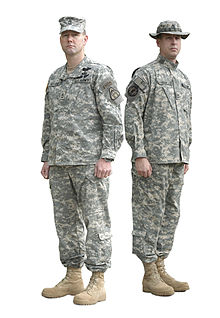Army Combat Uniform

The Army Combat Uniform ( ACU ) is the current combat uniform of the US Army . Unlike the previous US Army's battle dress uniform (BDU), the ACU uses a universal camouflage called Universal Camo Pattern (UCP) for all regions and seasons. At the BDU, different camouflage patterns were still in use for different regions, e.g. B. Woodland or 3C-Desert. The digital camouflage pattern , similar to the MARPAT camouflage pattern of the US Marine Corps , contains various shades of gray, beige and green. Various detail improvements were also introduced based on the soldiers' input.
Introduction to the Troop
The ACU replaces the BDU in the US Army, which has been in use since September 1981. The introduction to the force began in 2005, and this process was completed by the end of 2007. In the transition period, both the ACU and the old BDU were in use in different camouflage patterns. In the meantime, consideration is even being given to replacing the Army Combat Uniform in the Universal Camouflage Pattern with a version with the Multicam camouflage pattern , as the UCP camouflage pattern has not proven to be as efficient as it was initially thought. In Afghanistan, for example, the sand was way too dark for the ACU to be seen from afar. In addition, the ACU is not suitable for wooded areas. There were z. B. in Hohenfels and Grafenwoehr have seen newer uniforms with significantly more dark green, but no further details are known. In February 2010 it was decided to replace the ACU with MultiCam, but for the time being this should only apply to some US troops in Afghanistan. The ACU, which has proven itself in Iraq, will remain in service for the time being to test whether it can be used in other regions.
The uniform in detail

The uniform consists of the following parts:
- Headgear: a straight-flanked cap, as it was introduced in 1943 as a patrol or field cap in the US Army, but with a reinforced peak and an inside pocket. As usual in the US Army, the ACU is worn with the black beret inside military facilities . The unit leader can order the wearing of the field cap if it is not necessary to wear the helmet . Alternatively, the bush hat or brim hat is worn.
-
Field jacket :
- US Army and name tag with the surname
- Badge of rank in the middle of the chest
- Upper arm pockets with Velcro fastener for badges, such as: Unit, activity and identification badges, such as the US flag as infrared- reflecting fabric badges (this is used to identify friend and foe day and night). The left pocket contains three pen holders.
- Permanent infrared light reflecting squares are sewn onto each upper arm pocket for friend-foe detection and can be covered with a Velcro fastener if necessary.
- Highly closable stand-up collar with Velcro. This is worn with the "Outer Tactical Vest" (OTV), a combat and protective vest. Otherwise, the collar is worn in the folded-down position.
- Jacket zipper with additional Velcro fastener for use under the OTV
- Slanted chest and leg pockets with Velcro
- Freedom of movement at the elbows and knees to be able to wear protectors underneath
- Pockets in which you can insert knee and elbow protectors.
particularities
The ACU uses the same camouflage pattern as the US Marines ' MARPAT uniform , but with different colors, namely green, gray and sand. The color black was not used for the uniform, because “real” black is practically non-existent in nature and therefore attracts attention rather than camouflaging.
In peacetime, the normal, full-colored US flag is worn on the sleeve, otherwise a color-muffled infrared reflective version is worn. The same applies to the other badges.
There are infrared reflectors on the shoulders, which are used to identify friends and foes (IFF, Identify Friend-Foe).
The cost for each soldier to 76 US dollars per uniform (only field jacket, field trousers, sand-colored T-shirt, socks, belts, badges and name tag, and BDU-Cap - additional costs caused by sand-colored boots, rucksack, body armor, helmet , Camelbak hydration system and various MOLLE bags), unlike the old uniform for $ 58. However, this should change in their favor with increasing availability.
See also
Web links
- Article on globalsecurity.org (English)
- Side of the US Army to the ACU (English)
